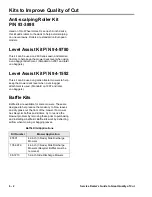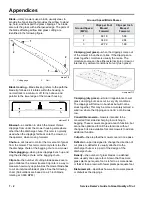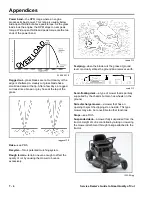
7 - 2
Service Dealer’s Guide to Great Quality of Cut
Appendices
Blade
—rotary mowers use a blade, usually steel, to
provide the fan action that provides the airflow to stand
up, hold, and transport the grass clippings. The blade
also cuts the grass with a sharpened edge. The parts of
the blade affecting airflow and grass cutting are
identified in the following figure.
blade.TIF
Blade tracking
—Blade tracking refers to the path the
blade tip follows as it rotates within the housing. A
normal track is a minimum of 1/8 inch above and
parallel to the lower edge of the mower housing.
bldtrack.TIF
Blowout
—a condition in which the mower throws
clippings from under the mower housing somewhere
other than the discharge chute. This term is normally
used when the clippings fall back onto the mower, or
the operator, when moving forward.
Chute
—a duct used to control the movement of grass
from the mower. This term commonly refers to either
the discharge chute or the bagging chute on a mower.
Chute plugging
—when grass clippings bunch up and
clog the discharge chute or the bagging chute.
Clip rate
—the number of cutting blade passes over a
given distance the mower travels. Clip rate is a way to
measure how many opportunities the mower blade has
to cut an individual blade of grass. See the following
chart. (Calculations are based on a 21-inch blade
rotating at 3,000 RPM.)
Clumping (wet grass)
—when the clippings come out
of the mower in bunches or piles. If the clippings are
stuck together, moisture is usually the cause. The
moisture source can be either external (rain or dew) or
internal (dry ambient conditions but very lush grass).
clumpwet.TIF
Clumping (dry grass)
—similar in appearance to wet
grass clumping but can occur in very dry conditions.
The clippings will fall out in bunches but will not be
stuck together. This may be more accurately termed a
windrow where the clippings are not in a continuous
row.
Convertible mowers
—mowers intended to be
converted from side discharging to mulching to
bagging. These mowers are good at each function, but
cannot be optimized for all three functions without
changes. Kits are available for some mowers to add an
additional function.
Cut path
—the area that the mower covers in one pass.
Deflector
—a part designed to change the direction of
cut grass. A deflector is usually attached to the
discharge chute or is a part of the design of the
discharge chute.
Density
—the number of grass blades in a defined
area, usually one square foot. A lawn that has more
grass plants per square foot is refer to as more dense
or thicker than a lawn with fewer plants per square foot.
Disbursement
—describes how well a mower spreads
or disburses the clippings.
1
1
2
2
1.
Cutting edge
2.
Sail
Ground Speed/Blade Passes
Ground Speed
(MPH)
Clips per Foot
Moved
Forward
Clips per Inch
Moved
Forward
1
68.18
5.68
2
34.09
2.84
3
22.72
1.89
Содержание Recycler 20351
Страница 1: ...MANUAL ...
Страница 6: ...iv Service Dealer s Guide to Great Quality of Cut This page intentionally left blank ...
Страница 8: ...1 2 Service Dealer s Guide to Great Quality of Cut This page intentionally left blank ...
Страница 12: ...2 4 Service Dealer s Guide to Great Quality of Cut This page intentionally left blank ...
Страница 16: ...3 4 Service Dealer s Guide to Great Quality of Cut This page intentionally left blank ...
Страница 40: ...4 24 Service Dealer s Guide to Great Quality of Cut This page intentionally left blank ...
Страница 44: ...5 4 Service Dealer s Guide to Great Quality of Cut This page intentionally left blank ...
Страница 56: ...7 10 Service Dealer s Guide to Great Quality of Cut This page intentionally left blank ...
Страница 57: ...QUALITY OF CUT MANUAL Form No 492 4763 ...










































